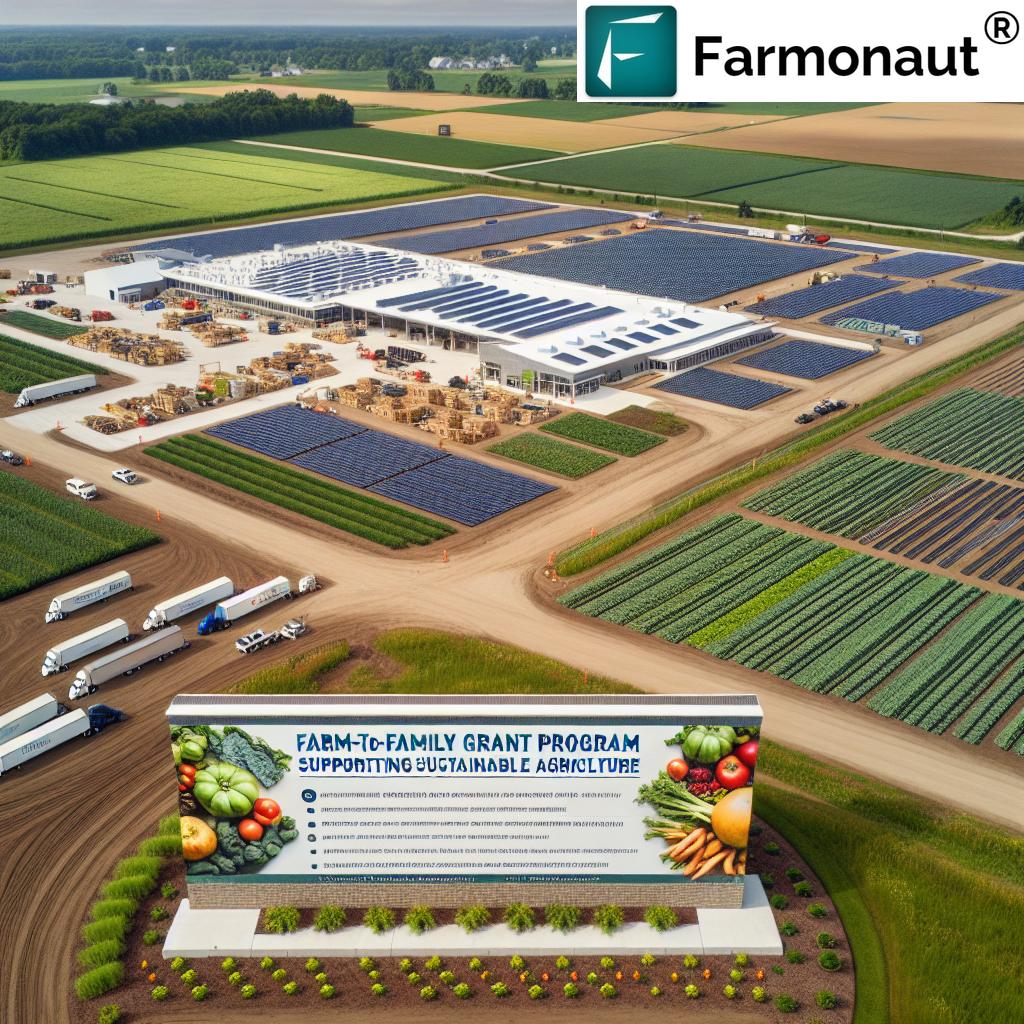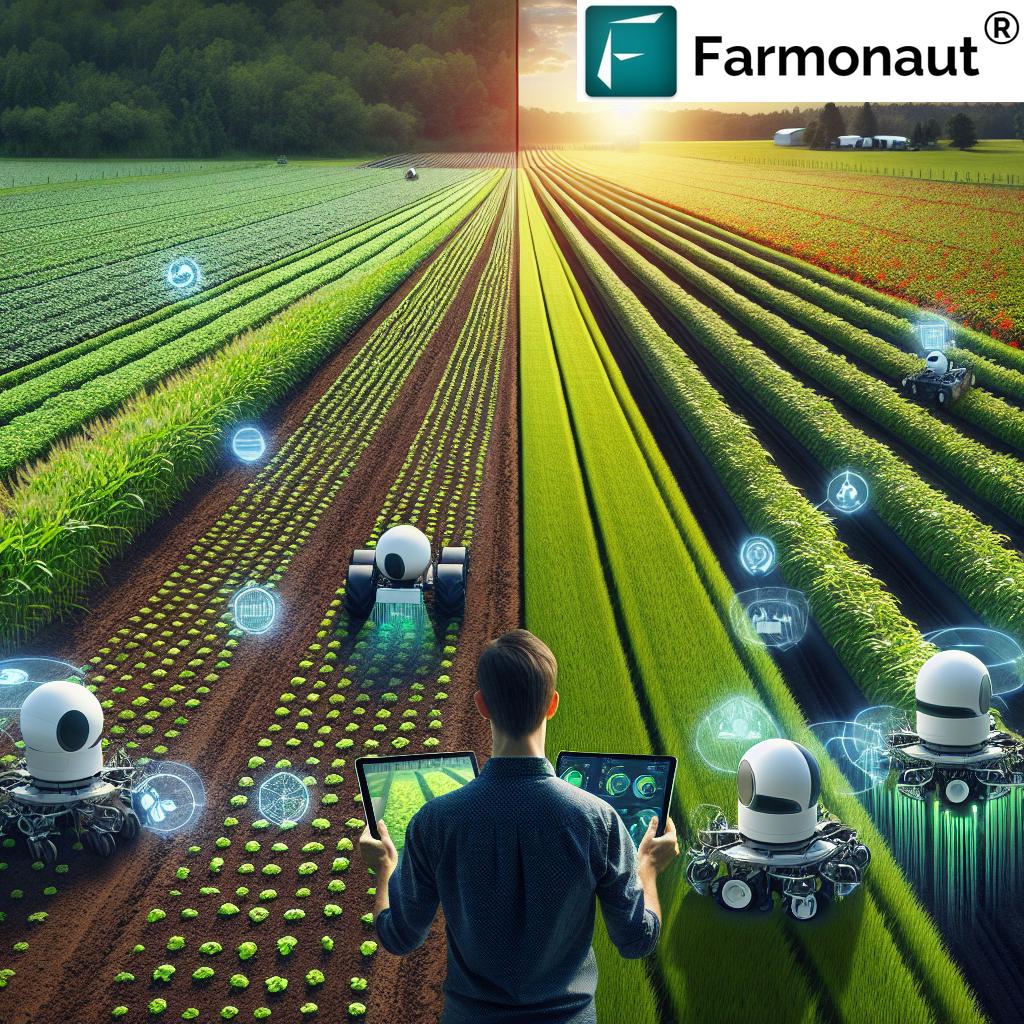How Machines & Tractors Changed Texas Agriculture Industry: The Mechanization Revolution for 2025 and Beyond
“By 2025, over 90% of Texas farms use tractors, boosting crop yields by nearly 40% since mechanization began.”
Farmonaut API for Satellite Data
Farmonaut API Developer Docs
Introduction
The Texas agriculture industry stands as a testament to the transformative power of machines, tractors, and mechanization. Today, in 2025, it is clear that the advent of mechanization and innovative technologies is not only the driving force behind the modernization of Texas agriculture but has been pivotal in fundamentally transforming the sector, boosting productivity, scalability, and economic growth in the state and beyond.
How did machines and tractors affect the agriculture industry in Texas? How did the industrial revolution affect agriculture? And how are we, as a society and industry in 2025, continuing to ride the wave of technological advancement toward even more efficient, sustainable, and profitable farming? These questions form the backbone of our exploration.
In this comprehensive guide, we will journey through the major eras of Texas farming, from its historically labor-intensive roots to today’s high-tech, data-driven operations. With a focus on mechanization, tractors, and emerging technologies, we will illustrate how each stage of transformation has contributed to the broader economic landscape and empowered Texas to remain a leading player in national and global agricultural markets.
Pre-Mechanization Texas Agriculture: Manual Labor & Animal Power
Historically, Texas agriculture was built on the persistent efforts of manual labor and animal-powered tools. In the 19th and early 20th centuries, farmers relied heavily on horses, mules, oxen, and handheld implements for plowing, sowing, cultivating, and harvesting. The vast landscape of Texas—with its fertile plains, rich blackland prairies, and expansive cotton fields—demanded strenuous, repetitive labor.
- Plows drawn by oxen or mules would break the tough sod, a physically intensive process requiring many hours per acre.
- Planting corn, wheat, cotton, and sorghum was slow, often done by hand or with rudimentary seeders.
- Harvesting crops meant weeks or months of back-breaking work, often requiring entire rural communities to band together.
The productivity and scale of these early farms were inherently limited by the amount of available labor and time. The lack of machinery meant weather, pest infestations, and soil conditions could devastate yields. Farms were typically small, family-run operations with minimal output destined primarily for local consumption or trade.
As global markets and population pressures grew, it became clear that methods would need to change to satisfy increasing food demands and sustain the Texas economy.
The Advent of Machines & Tractors: Landmark Turning Points
The introduction of tractors and advanced machines in the early- to mid-20th century marked a significant turning point in the Texas agriculture industry. Mechanization began with steam-powered tractors in the early 1900s, and later, gasoline- and diesel-powered models that made farm labor both faster and more efficient.
- Tractors equipped with plows, seed drills, cultivators, and eventually combines revolutionized farming in Texas.
- Farmers could now till, plant, cultivate, and harvest larger areas—often multiple times faster than manual methods.
- The labor force required per acre dramatically decreased as machinery replaced traditional plowing methods and manual weeding.
The effects were felt across farm sizes and crop types, but especially in the production of Texas staples such as cotton, corn, wheat, and sorghum. Tractors and combines enabled Texas farmers to cultivate vast tracts of land, driving a sustained agricultural boom in the 20th century.
How Did Machines and Tractors Affect the Agriculture Industry in Texas?
- The transition from manual labor to mechanized farming drastically reduced the time and effort required to plant, till, and harvest.
- With advanced implements, Texas farming operations became more efficient, productive, and profitable.
- This acceleration created a boom in crop production and rural incomes, spurring further adoption of machinery across the state.
Mechanization’s Effect on Productivity & Scale: Yield Improvements & Scalability
How did machines and tractors affect the agriculture industry in Texas? The most notable and measurable impact was on productivity—from individual farm output to statewide agricultural GDP.
- Tractor adoption allowed farmers to manage more acreage without increasing labor costs.
- Crop yields (bushels per acre) increased steadily, as mechanization improved the precision and timeliness of planting, fertilizing, and harvesting.
- Farm labor productivity—the amount of output per worker—soared, freeing workers for other rural industries as well.
For example, by the 1950s, nearly half of Texas farms had adopted tractors, which cut labor hours per acre by over 60% compared to pre-tractor days. By 2025, over 90% of Texas farms use tractors, especially in the cotton, corn, and sorghum belts. This has resulted in a near 40% increase in average crop yields since full-scale mechanization began.
The benefits of scalability were immediately apparent. Larger, commercial farms emerged, consolidating resources and capitalizing on economies of scale made possible only with modern machinery.
Historical Impact of Agricultural Mechanization in Texas: Key Metrics Comparison
| Year/Decade | Mechanization Milestone | Estimated Tractor Use (% of Farms) | Average Crop Yield (bushels/acre) | Estimated Labor Hours per Acre | Economic Output (USD millions) |
|---|---|---|---|---|---|
| 1920s | First tractors arrive; limited adoption | ~4% | Cotton: 180 Corn: 28 |
40–60 | $1,200 |
| 1950s | Widespread tractor adoption; emergence of combines | ~48% | Cotton: 250 Corn: 45 |
15–20 | $6,500 |
| 1980s | Introduction of GPS; larger, high-tech machinery | ~75% | Cotton: 270 Corn: 100 |
8–10 | $16,800 |
| 2025 | Smart tractors, precision ag tools, real-time satellite data | >90% | Cotton: 360 Corn: 140 |
2–4 | $32,500 |
*Values are estimated for illustration. Crop yields are average values; actuals vary by region.
Mechanization & Economic Growth: How Did Changes in Agriculture Affect the Texas Economy?
As mechanization revolutionized farm productivity, it also drove profound economic changes in Texas. The question, how did changes in agriculture affect the Texas economy? is answered through several key trends:
-
Substantial Increase in State GDP:
A more mechanized Texas agriculture industry led to higher output per acre and farm, boosting the gross domestic product.
As of 2025, agriculture and related sectors contribute a significant share to the Texas GDP, supporting financial health and business infrastructure throughout the state. -
Rural Employment & Ancillary Industry Growth:
Employment opportunities shifted from low-skilled farm labor to higher-skilled machinery operation, repair, and precision agriculture roles. Related ancillary industries—manufacturing of farm machinery, fertilizer production, and transportation services—flourished as demand for equipment, logistics, and processing grew. -
Export & Global Market Integration:
Higher, more reliable crop yields positioned Texas as an international exporter for products like cotton, grain, and beef, bringing new streams of foreign capital into the economy. -
Rural Transformation & Urbanization:
As fewer workers were needed on farms, rural populations declined, prompting migration to Texas cities and the rise of urban hubs like Dallas-Fort Worth, Houston, and Austin. This labor shift contributed to economic diversification and the state’s resilience in the face of shifting agricultural or energy market demands.
Mechanization not only transformed individual farms—it fundamentally reshaped Texas’ broader economic landscape.
Explore Farmonaut’s Large-Scale Farm Management Tools for advanced mapping and analytics solutions that optimize operations and resource allocation for commercial Texas farms.
“Texas agriculture’s mechanization increased farm labor productivity by 300% between 1950 and 2025.”
How Did the Industrial Revolution Affect Agriculture? Technology Emerges as a Driving Force
The Industrial Revolution—spanning roughly the late 1700s through the 1800s—was a period of dramatic change for agriculture as well as manufacturing. It introduced revolutionary innovations in machinery, energy, and materials science that soon crossed over into the world of farming.
For Texas agriculture, this era meant:
- The evolution of the steam engine and, later, the internal combustion engine, which would eventually power tractors and harvesters.
- Breakthroughs in metallurgy and engineering (steel plows, durable gears, and bearings) made reliable, long-lasting farm equipment possible.
- Revolutionary transportation infrastructure (railroads and mechanized shipping) opened access to national and international markets, enabling Texas crops to reach buyers across the country and globe.
From Hand Tools to Mechanization: A Timeline
- Early 20th century: Introduction of gasoline-powered tractors begins widespread replacement of animal labor.
- Mid-20th century: Combines, seed drills, and cultivators enable efficient multi-step operations—tilling, planting, fertilizing—in one pass.
- Late 20th to Early 21st century: Technology leapfrogs again with electronic guidance, yield monitors, and eventually GPS precision farming.
Texas, with its vast landscapes and emphasis on cash crops, became ideally positioned to adopt, scale, and innovate upon these global trends, further cementing its reputation as an agricultural powerhouse.
Read more about our Farmonaut Fleet Management system, which helps Texas farm businesses optimize machinery usage and logistics for today’s scale.
Farm Consolidation & Commercialization: Toward Larger Operations
While mechanization unlocked new productivity gains, it also set in motion a shift toward commercial and large-scale farming—a trend that has accelerated through to 2025.
- Smaller farms found it increasingly difficult to compete without investing in machinery, precision equipment, and modern data solutions.
- This prompted a consolidation of farmland: larger operations absorbed smaller, less mechanized farms, expanding their acreage to maximize returns on technological investments.
- The trend toward agribusiness has also integrated farm production with processing, storage, transportation, and marketing functions.
Today, in 2025, Texas agribusiness firms operate across thousands—sometimes tens of thousands—of acres, leveraging the latest machinery for every step, from precision planting to blockchain-based traceability solutions in crop supply chains.
For traceability, crop verification, and food safety, modern farms can use Farmonaut’s Carbon Footprinting Platform to document and mitigate emissions, ensuring sustainable production for global export requirements.
Explore our Satellite-based Crop Loan and Insurance Verification tools—enabling fairer, faster agricultural finance for Texas farms.
Integration, Agribusiness, and Global Markets: Meeting National & International Demands
Mechanization isn’t just about tractors or productivity—it is the linchpin for Texas’s integration into global agricultural markets. By enabling higher, more reliable output, mechanized Texas farms:
- Meet the demands of national and international buyers for bulk crops including cotton, corn, wheat, and sorghum, all of which remain mainstays for the regional economy.
- Support robust sectors for processing, packaging, storage, and export logistics—further multiplying economic impact.
- Lead to diversified revenue streams for rural communities, supporting livelihoods well beyond farm gates.
This seamless integration has attracted investment and innovation, keeping Texas at the leading edge of agricultural technology and market expansion—critical considerations for 2025 and beyond.
Modernization & Advanced Mechanization in Texas Agriculture (2025 & Beyond)
By 2025, the Texas agriculture industry is a living case study of continued innovation and modernization:
- Over 90% of Texas farms are mechanized; even smallholders have access to precision tools, smart implements, and AI-driven advisory systems.
- Data-driven agriculture is the norm, with real-time monitoring, variable input management, and yield analytics powering decision-making.
- Sustainability and climate resilience are front and center—whether through advanced irrigation, satellite crop monitoring, or carbon footprint tracking.
Examples of Advanced Mechanization in Texas Farms
- Autonomous tractors and drone fleets supporting large-scale crop management.
- Widespread use of precision planting, GPS guidance, and smart combines for record-setting yields.
- Integration of blockchain and cloud platforms for end-to-end supply chain transparency—like Farmonaut’s traceability solutions.
For plantation forestry, crop rotation, and advisory, take advantage of Farmonaut’s Crop Plantation & Forest Advisory—customized guidance using real-time and historical data.
The Role of Precision Agriculture & Smart Machinery: The New Age of Mechanization
In Texas, the latest revolution is “smart” mechanization. This involves not only physical machines but also embedded software, satellite feeds, and AI-assisted tools. Today, precision agriculture enables Texas farmers to achieve new levels of efficiency, sustainability, and profitability.
-
GPS-Guided Tractors:
These tractors auto-steer, optimize tillage, and plant seeds at optimal densities, reducing overlaps and wasted inputs. The result: better yields, less fuel, and lower emissions. -
Satellite Monitoring & Drones:
Multispectral imaging highlights crop health issues before they’re visible on the ground. Scouting and input applications are safer, faster, and more targeted. -
AI-Driven Decision Support:
Today’s platforms—like those powered by AI and satellite feeds—give real-time advisories for irrigation, fertilization, and pest management (Farmonaut Large-Scale Farm Management Application). -
Blockchain Traceability:
From planting to distribution, blockchain ensures every product is secure, verifiable, and globally marketable (Farmonaut’s Product Traceability Solutions).
With smart mechanization and real-time data at every step, Texas stands at the forefront of the next agricultural revolution.
How We at Farmonaut Empower the Next Generation of Texas Agriculture
At Farmonaut, we recognize that mechanization and technology go hand in hand. Our mission is to make satellite-driven insights affordable and accessible to every business, user, and government—including those in the thriving Texas agriculture industry.
- Satellite-Based Crop Monitoring: Our multispectral imaging tracks crop health (NDVI), soil moisture, and growth trends to empower farmers and business operators with actionable intelligence.
- AI Advisory for Productivity: Jeevn AI delivers real-time, tailored strategies based on satellite data, from irrigation scheduling to weather risk alerts.
- Blockchain Traceability: Secure your harvests and supply chain for global markets with blockchain transparency.
- Fleet & Resource Management: Optimize farm machinery, reduce operational costs, and ensure safety compliance across even the largest operations.
- Environmental Impact Monitoring: Track your carbon footprint, comply with regulations, and lead on sustainability in agriculture and beyond.
Our solutions are available via web and mobile app (download here) or API access (Farmonaut API), and can be deployed to support smallholders, commercial agribusiness, and government stakeholders.
With a focus on efficiency, transparency, and sustainability, we enable Texas and global agriculture to meet modern challenges and opportunities head-on.
Frequently Asked Questions (FAQ)
How did machines and tractors affect the agriculture industry in Texas?
Machines and tractors allowed Texas farmers to farm larger areas more efficiently, drastically reduce labor hours, increase yields, and support the growth of commercial agriculture. This transformation revolutionized Texas agriculture by improving productivity, profitability, and market competitiveness.
How did changes in agriculture affect the Texas economy?
Mechanization led to higher state GDP, more exports, and broader employment in ancillary industries such as farm machinery manufacturing, transportation, and fertilizer production. It also fueled rural community development, urbanization, and overall diversification of the Texas economy.
How did the Industrial Revolution affect agriculture in Texas?
The Industrial Revolution introduced engines, advanced metallurgy, and large-scale manufacturing to farming. This enabled the development of tractors and robust implements, transforming Texas’s agricultural landscape by facilitating large-scale, efficient farming and global market integration.
Why is mechanization key to Texas agriculture in 2025?
Mechanization continues to enable precision, sustainability, scalability, and resilience. With the adoption of smart farming tools, sensors, and satellite insights, Texas farms are positioned to withstand climate risks, maximize output, and remain globally competitive.
How are advanced technologies shaping the future of Texas agriculture?
AI, IoT, drones, and satellite monitoring (such as those via Farmonaut) are providing real-time data-driven support for farming operations. These technologies enable site-specific management, efficient resource use, transparency, and higher productivity across Texas farms.
Where can I learn more about Farmonaut’s agriculture solutions?
Access our main app, API for developers, and product traceability tools—all designed to support farmers and agribusinesses in Texas and worldwide.
Conclusion
The advent of machines and tractors revolutionized the agriculture industry in Texas. From the earliest animal-powered tools to autonomous, AI-enabled machinery in 2025, the trajectory of Texas farming has always been shaped by the pursuit of efficiency, scale, and innovation.
Mechanization has played a crucial role in Texas’s economic growth, transitioning rural communities and markets, and ensuring that the state’s agricultural producers remain competitive and sustainable globally. The impacts go far beyond productivity: they include shifts toward larger farms, agribusiness integration, and robust support industries.
As we move further into the era of precision agriculture, smart mechanization, and data-driven decisions, the Texas agriculture industry remains a model for how technology and innovation can empower prosperity at the farm, community, and state level.
At Farmonaut, we are proud to enable Texas producers, business owners, and governments with satellite-based insights and smart management solutions—helping write the next chapter of this remarkable story.













